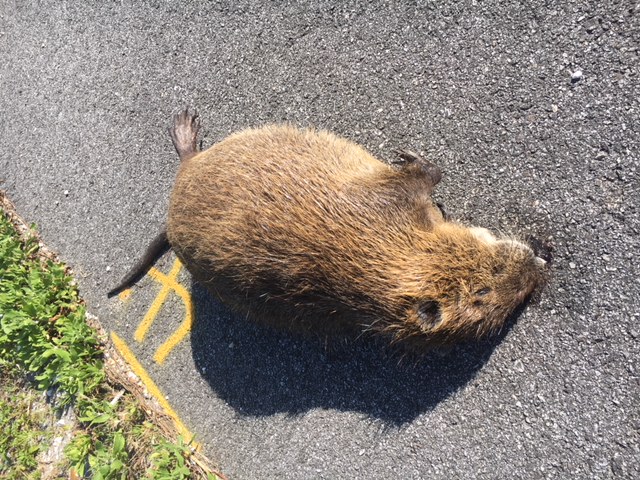
by Rick O'Connor | Jun 28, 2019
I found one in Escambia County, near Perdido Key. It was dead, roadkill, and was quite large. Needless to say, working with invasive species and trying to stay ahead of any new potential problems, I was surprised. I immediately turned around to confirm what I saw as I drove by – it was a nutria.
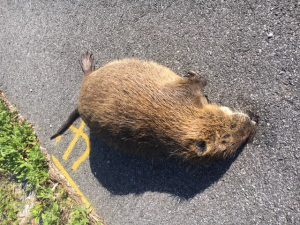
A dead nutria found along a roadside in Escambia County.
Photo: Rick O’Connor
Many of us have heard of this large rodent (Myocastor coypus), and all the problems it has caused in the state of Louisiana. With the loss of their marshes at stake, it was “all hands” to battle this guy. From reading, it appears it was released across the United States as a potential fur product. I found statements that they may have been brought here from their home in South America as early as the 19th century. Certainly, by the 1920s and 1930s they were here. Today there are records in 18 states across the southeast, the Chesapeake Bay area, and the Pacific northwest – a widespread release and distribution.
It is another classic invasive species story. A nonnative creature is brought to the United States for some specific reason, sometimes accidentally; escapes into the local environment, or is intentionally released; has no natural predators so begins to reproduce at a high rate; and causes environmental and/or economic problems. The United States spends hundreds of millions of each year battling such species.
In the nutria’s case, it is from South America. It was hard to determine whether they were brought over here in small increments to different locations over time, or whether they were brought here in bulk and released into habitats they could survive in, but they were released. It is a large rodent and resembles a beaver except that its tail is round, and not flat, and the profile of their back has an arch to it. They can reach two feet in length, not counting tail, and can weigh up to 20 pounds.
They are herbivores, and some used this animal to control aquatic plants in their ponds. Like many rodents, they have an aggressive reproductive rate to overcoming predation. Nutria become sexually mature within 4-6 months and can produce their first litter at eight months. They breed year-round and typically have three litters / year with 2-13 young / litter. Gestation is 128-130 days and the females are ready to breed within 48 hours of birth.
Nutria like water and can survive in brackish conditions. They live in small social groups that typically have a dominant male, 2-3 females, and the young. Activity is usually at night, moving through the habitat consuming 25% of their body weight in plants each day. They can be seen during daylight hours if food is scarce.
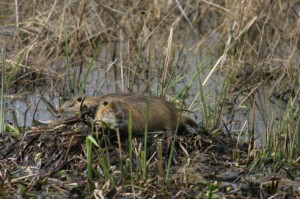
Photo Courtesy of US Fish & Wildlife National Digital Library
So, what’s the problem?
They eat a lot and burrow for denning. Many waterways are endangered due to their destructive habits. The tunneling and burrowing can compromise the integrity of banks and shorelines around these waterways. Louisiana, being a state with many levees holding water back from communities, you can understand their concern; but communities in Washington, Oregon, and Maryland are facing the same issues. They are carries of certain pathogens and parasites, such as tuberculosis, septicemia, and liver flukes which can be a threat to humans and pets. They also carry nematodes which can trigger a condition known as “nutria itch” in waterways where they are found.
In 1938, 20 nutria were released in Louisiana. By 1958 there were 20 million in the state. There did not seem to be any natural control and the state began losing its marshes. The interesting thing is there are records of releases in Florida as far back as 1955. There are records of this animal in the Pensacola area dating back to 1956. Yet, we do not see the overwhelming numbers found in Louisiana, or with lionfish in our area. I spoke with long time Mobile Delta natural historian Jimbo Meador about the problem there. He said there were lots of nutria at one time and they had hunting tournaments to control them. But when the state began protecting alligators the nutria problem went away – a natural predator after all. He said today you can still find nutria in the Mobile area, but they are restricted to the more brackish areas where alligators are not as common.
Which brings us back to the Pensacola issue.
Many believe that the best method for controlling a new potential invasive species is discover and manage them early before they become widespread and established. Even though this is the first one I have seen in Escambia County, they apparently have been in the area for over 60 years. Something seems to be controlling their populations, which is a good thing. That said, any populations found should be monitored so they do not become more widespread. Currently, the Florida Fish and Wildlife Conservation Commission considers them as one of the furbearers and manages them as such. Live trapping is allowed but you must have a trapping permit to do so. You can actually sell the fur, but you will need a license for this. This may be like the tiger shrimp story, an invasive we are aware of but is not becoming a widespread problem in the county, but I do recommend anyone seeing the creature report to the website data base www.EDDMapS.org so that we can all keep track of where they are and whether they are spreading.
References
California’s Invaders: Nutria (Myocastor coypus), California Department of Fish and Wildlife
https://www.wildlife.ca.gov/Conservation/Invasives/Species/Nutria.
Jimbo Meador (personal communication)
Maryland Mammals: Nutria (Mycastor coypus), Maryland Department of Natural Resources
http://dnr.maryland.gov/wildlife/Pages/plants_wildlife/Nutria.aspx.
Nutria Biology and Identification, Chesapeake Bay Nutria Eradication Project, U.S. Fish and Wildlife
https://www.fws.gov/chesapeakenutriaproject/Biology.html.
Nutria (Myocastor coypus), Florida’s Nonnative Wildlife Species Detail, Florida Fish and Wildlife Conservation Commission.
https://myfwc.com/wildlifehabitats/nonnatives/mammals/rodents/nutria/.
USGS, Nonindigenous Aquatic Species, Nutria (Myocastor coypus)
https://nas.er.usgs.gov/queries/FactSheet.aspx?speciesID=1089.

by Rick O'Connor | Jun 28, 2019
Or just mullet… maybe you prefer “mu-lay”…
Either way it is a fish we all know and love. Those of us who grew up here on the Gulf coast know this fish as part of our culture. I remember numerous family gatherings where fried mullet was the order of the day. Along with grits, baked beans, cole slaw, and iced tea you had your “mullet plate”. It is the fish of choice for Catholic fish fries during Lent. It is the icon of the “Mullet Toss” event at the Flora-Bama, which draws huge crowds and people plan for all year. It almost became the mascot of minor league baseball team. One my favorites was a story told to me by a colleague who used to teach at the old Booker T. Washington High School when it was on “A” street. He told me each morning the janitorial staff would catch mullet for the school lunches. They would have your classic “mullet plate” for lunch everyday – fresh from the bay – how good is that. It is the fish that “jumps” and everyone knows what it is.

The Striped Mullet.
Image: LSU Extension
I paddle area waters monitoring a variety of things assessing the health status of Pensacola Bay. While out there I see a lot of wildlife, but mullet is one of the more common ones. Wherever I go, open intracoastal waterway, grassbeds, bayous, marshes, even backwater creeks where the water is almost stagnant, I find mullet. You see their swirls, schools gliding beneath your paddleboard or kayak, I even watched one make unusual circles with its head above water once. And always the “jump”, they are always jumping. But I had never really thought much about their biology. Many folks observe and study more unusual, or problematic fish, like lionfish. But the mullet slips by the radar. It is more like… “oh yea, then there is the mullet”, and we do not think of them more than that.
Local recreational and commercial fishermen are aware of their movements and behaviors. They know when and where they will be at different times of the year. But I thought I would do some digging and educate the rest of you about this amazing fish who is like part of the family.
There are actually two species of mullet swimming in area waters. The striped mullet (Mugil cephalus) is more common. It is one that the commercial fishermen seek, FWC lists as the “black mullet” on their commercial guides. The other is the white mullet (Mugil curema). They differ in that the anal fin of the white mullet has 9 soft rays; the striped has 8. Large striped mullet will have stripes, which the large white mullet lack. The juveniles of both species lack stripes. When caught and still alive, the white mullet will have a bright gold spot on the operculum (the bone covering the gills), this is lacking on the striped mullet.
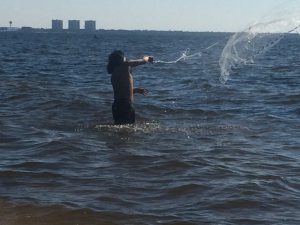
A fisherman throws a cast net to catch mullet at White Point in Choctawhatchee Bay
Mullet are euryhaline… meaning they can tolerate a wide range of salinities and can be found in fresh or saltwater. They travel in schools, feeding off of the bottom. Their diet consists of bacteria and single-celled algae found attached to plants. They pick at the bottom, and scrape seagrasses consuming these.
They spawn most of the year, but the peak is between October and December. Spawning takes place in the open Gulf of Mexico, sometimes far offshore. They become sexual mature at three years old and can produce 0.5 – 4 million eggs. Mullet roe (fish eggs) is a local delicacy for some. They have been reported at an age of 16 years – long time for a fish.
While studying marine biology in college, I remember someone asked our professor why mullet jump. He paused for several seconds and then replied – “for the same reason manta rays jump”… there was a long pause… so we bit the bait – “okay, why do manta rays jump?” “We don’t know”. Classic…
However, they now have an idea why. It is believed they clean their gills doing this and also oxygenate those gills in stagnant, warm, low oxygen waters that mullet find themselves in periodically.
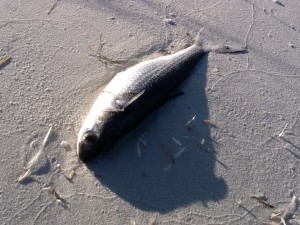
A striped mullet died during cold stress.
It is a local commercial fishery. Between 2018-2019 412,421 pounds of mullet were landed in Escambia County, another 151,638 pounds in Santa Rosa. This made it the number one fish for the season. Between the two counties the value of the fishery was $456,892 but sells better as a bait than as food.
It is truly a magnificent fish. Their numbers have increased since the 1995 net ban and has become one of the more common fish we see while exploring local estuarine waters. I certainly will not take them for granted any longer.
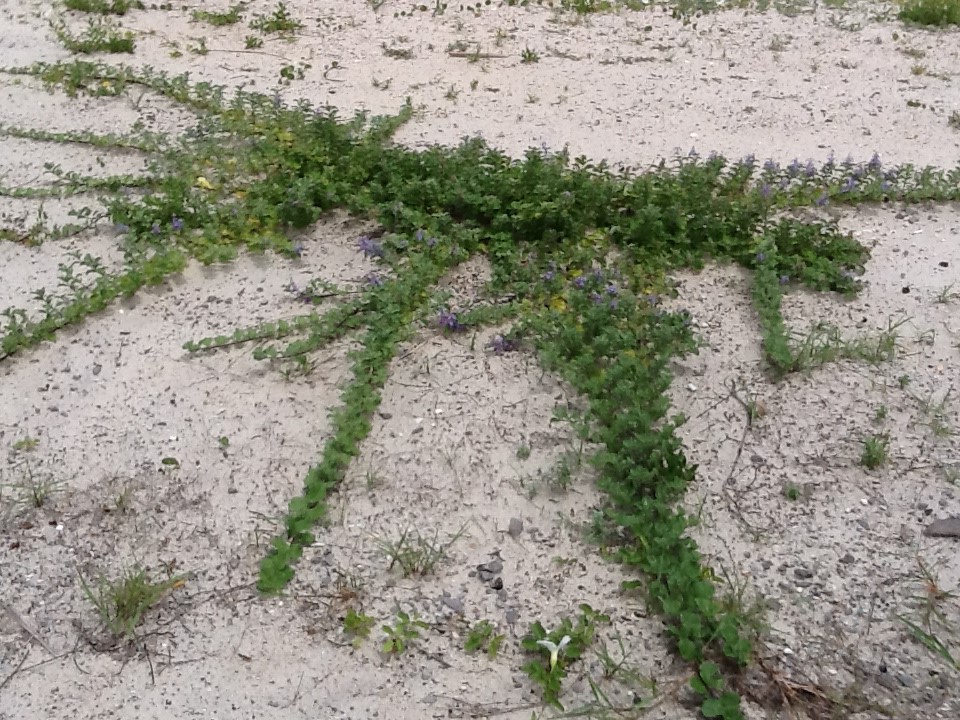
by Rick O'Connor | Jun 18, 2019
Yep,
We are still trying to remove this invasive plant from our area. For those who are not familiar with it, beach vitex (Vitex rotundifolia) is a category I invasive plant in Florida. It is current listed as “invasive, not recommended”. This means you can still purchase it but recommend you do not.
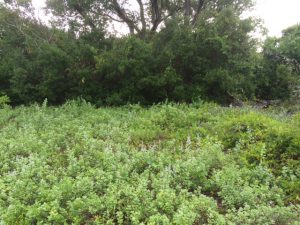
Vitex growing at Gulf Islands National Seashore that has been removed. Photo credit: Rick O’Connor
Why is that?
Well, being an invasive species, it reproduces at a high rate, has few consumers, and causes an environmental issue wherever it grows. It has the potential to cause economic issues as well. Beach vitex is from Asia and was brought to the United States as an ornamental plant. In upland landscapes, it does not seem to be a problem. However, when first used in coastal dunes it began to show its ugly head. Vitex begins as a low growing vine and becomes a shrub over time. It produced a beautiful lavender blossom in spring but then produces millions of seeds in late summer and fall. The seeds are spread by birds and are viable in seawater for several months. Dispersed in this way, the plant spreads across coastal beaches of our barrier islands.
Once established it forms a taproot with above ground rhizomes extending as far as 20 feet. It is allelopathic, meaning it produces chemical compounds that kill nearby plants and spreads to cover this new territory. This includes the common sea oat. Sea oats have a fibrous root system which are good at trapping sand and forming dunes. These dunes can protect properties during storm surge. Beach vitex, having a taproot system, are not as effective. Though we are not aware of any beach vitex growing on the fore dune in the panhandle, if it does it could impact sea turtle nesting. We are also not sure whether the local beach mice will eat these seeds. Thus, displacing sea oats could impact beach mice.
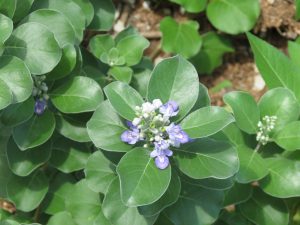
Beach Vitex Blossom. Photo credit: Rick O’Connor
We currently know of one site in Ft. Pickens, two properties in Gulf Breeze, two in Navarre, four on Perdido Key and Perdido Bay, 24 within Naval Live Oaks in Gulf Breeze, and 38 on Pensacola Beach; 70 properties total in the Pensacola Bay area. One of the properties in Gulf Breeze, and nine on Pensacola Beach (14%) have been removed or treated and have not returned. One property in Gulf Breeze, one in Ft. Pickens, two on Perdido Key and Perdido Bay, 20 on Pensacola Beach, and 24 in Naval Live Oaks (68%) have been removed or treated but have returned; re-treatments are required and are being conducted. And one property in Gulf Breeze, two in Navarre, two on Perdido Key or Perdido Bay, and nine on Pensacola Bay (20%) have not been removed or treated at all. In each of these cases, the plants are on private property. We hope that these property owners would consider removing the plant and replacing with native dune plants from this area.
Elsewhere in the panhandle we are aware of only two locations, one in Okaloosa County and one in Franklin. We believe the property in Okaloosa has been treated and are not sure of the status in Franklin. If is very possible that this plant is in the coastal areas of other counties in the panhandle.
Recently, volunteers from the Pensacola Beach Advocates and Americorp removed 315 m2 of beach vitex from public land on Pensacola Beach. That now means all beach vitex on public lands in Escambia County have been removed or treated. Research shows that repeated treatments may be required for up to five years to completely eradicate the plant from that property, but PBA and Americorp plan to assist Sea Grant with removing this plant from the area.
If you believe you have this plant and would like to learn how to manage it. Contact Rick O’Connor at the Escambia County Extension Office. (850) 475-5230 ext.111.
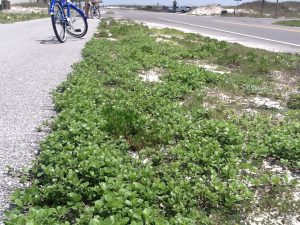
Vitex beginning to take over bike path on Pensacola Beach. Photo credit: Rick O’Connor
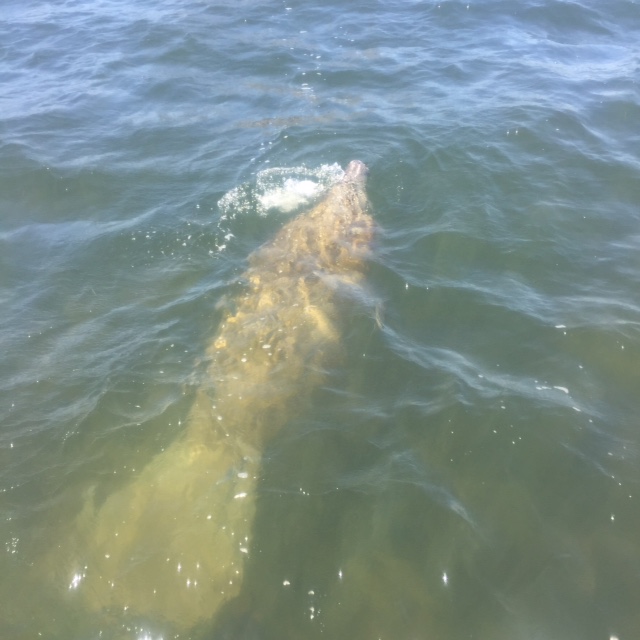
by Rick O'Connor | Jun 7, 2019
This is becoming an annual summer encounter – manatees in (near) the Intracoastal Waterway of Pensacola Bay area. They have been before, it is not uncommon for them to be seen at Palafox Pier Marina, but in the last few years groups of five to nine manatees have been spotted drifting along the shorelines and hanging around docks in Gulf Breeze and the Perdido Key area.
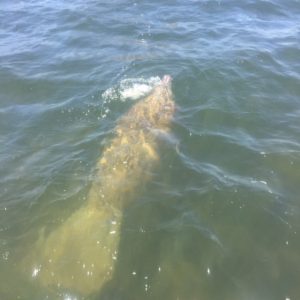
Manatee swimming in Big Lagoon near Pensacola.
Photo: Marsha Stanton
I cannot say what this means but we are not alone with these new visitors along the Gulf coast. There are enough manatee sightings in the lower portions of Mobile Bay that manatee signs have been placed along Magnolia River and a manatee watch hotline has been set up at Dauphin Island Sea Lab. There are at least 40 resident manatees in the Wakulla River. And now, at least in the last two years, small groups have been seen in our area. Concerned whether these manatees were returning to southwest Florida for the winter during the red tide, there were plans to tag some of them – I am not sure if that was done or not.
So, what does this mean for us?
Well, your first thought is the concern over boat strikes. The manatee has actually been protected by Florida law since 1893. Their numbers have increased to 6600 animals and so their status has been changed from endangered to threatened. That said, they are still protected by both the Endangered Species Act and the Marine Mammal Protection Act.
According to an FWC report, in 2018, 824 manatees died in Florida. The top five causes were (1) Natural causes – 27%, (2) Undetermined – 20%, (3) Watercraft – 15%, (4) Perinatal death – 14%, and (5) Unrecovered – 13%.
There were 17 deaths reported from the Florida panhandle. Wakulla (7), Franklin and Escambia (3), Bay, Gulf, Okaloosa, and Walton (1).
Cold stress was the #1 cause of death (7) – Bay, Escambia, Franklin, Okaloosa, and Walton
Followed by boat strikes (4) – Wakulla (2), Escambia (2)
Unrecovered (3) – Franklin, Gulf, and Wakulla
Undetermined (2) – Wakulla
Perinatal (1) – Wakulla
Natural (1) – Wakulla
So far, in 2019 there have been 259 manatee fatalities. The top five causes were (1) Watercraft – 25%, (2) Undetermined – 24%, (3) Cold stress – 15%, (4) Unrecovered – 13%, and (5) Natural – 13%
In the Florida panhandle there have been four deaths so far. Bay County has had two due to cold stress and Wakulla has had two – one was unrecovered and the other was “other” but human related.
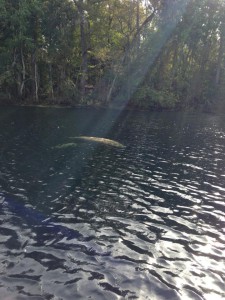
Manatees hanging out in Wakulla Springs.
Photo provided by Scott Jackson
So, statewide watercraft are still a big concern. Two of the three deaths in Escambia were boat related. The manatees tend to stay out of the boat channels, so it is recommend boaters remain in the navigable channels while heading to a destination and, when leaving the channel to reach that destination, go idle speed and have a lookout.
Manatees have actually benefitted the management of invasive hydrilla in the Wakulla River. FWC no longer has to treat it – the manatees are eating it all. Pensacola Bay is currently experiencing a bloom of epiphytic (attached) drift algae on the seagrass beds. Maybe, just maybe, the few manatees we see will consume as much algae they can.
I can understand the concern some boaters may have with manatees in the area. However, they do provide some benefits and are the highlight of the day for any local or visitor who may see them. We should welcome them and do what we can, within the law, to keep them safe. If you spot a manatee, please report it to the Dauphin Island Sea Lab hotline: 1-866-493-5803. Or email manatee@disl.org.

by Rick O'Connor | May 17, 2019
I am writing about this animal because, though it is rare to see them, our terrapin volunteers saw two this past week; and maybe you will too.
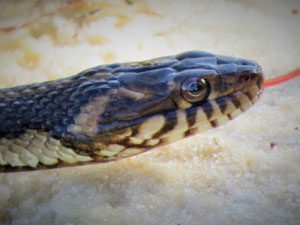
The round pupil and vertical jaw stripes indicate this is the nonvenomous Nerodia. Photo: Carole Tebay
The Gulf salt marsh snake is one of those, like the eastern coral snake, that is actually common – just rare to see. It is rare to see because (a) it lives in muddy salt marshes, where we rarely venture, and (b) it is mostly nocturnal – and even fewer of us venture into muddy salt marshes at night.
It is in the genus Nerodia, which includes the common water snakes like the banded water snake (Nerodia fasicata). It is a harmless nonvenomous snake. However, because of where it lives, it is often confused with a cottonmouth and is killed. A common name for this snake in Alabama is “bay moccasin”.
Their name is Nerodia clarkii, but it is a subspecies of this group – so the actual name is Nerodia clarkii clarkii. The other two subspecies are found in Florida. The Mangrove salt marsh snake (Nerodia clarkii compressicauda) is found from central Gulf coast of Florida, around the Keys to Indian River County on the Atlantic coast. The Atlantic salt marsh snake (Nerodia clarkii taeniata) has a very small range. Originally reported in Volusia, Brevard, and Indian River counties – due to the northern expansion of mangroves, it is believed to only be in Volusia County now. It is listed as THREATENED both federally and with the state. Our Gulf salt marsh snake is found from central Florida to Texas.
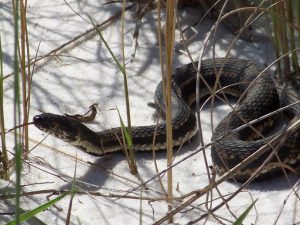
The nonvenomous Gulf Salt marsh Snake.
Photo: Molly O’Connor
It is a relatively small snake, only reaching a length of around 15-20 inches, though some have been reported at 30 inches. They possess two long yellowish-tan stripes running laterally the length of its body, the only species of Nerodia to do so. Again, they move at night feeding on small crabs, shrimp, frogs, and small fish. During daylight hours they hide beneath the wrack or other vegetation avoiding herons, egrets, and larger blue crabs. Lacking the needed glands, they cannot desalinate seawater the way sea turtles and terrapins can. All of their freshwater comes from their food and from rainfall.
They breed in the spring, possibly why we are seeing them now, and give live birth to about 10 young in midsummer. They are of moderate conservation concern in Alabama due to the loss of salt marsh. The loss of salt marsh habitat and rise of sea level are their major concerns at this point.
I do need to warn you, though it is a small, nonvenomous snake, they will bite. If bitten, soap and water will do the job. For me, and others, it is actually exciting to see them because of their reclusive nature. If you see one while exploring our intracoastal waters, know that you are not in any danger but rather lucky to see this “mystery of the marsh”.

The Gulf Salt Marsh Snake swimming in a local marsh.
Photo: Carole Tebay
References
Gulf Salt Marsh Snake – Texas Parks and Recreation – https://tpwd.texas.gov/huntwild/wild/species/gulfsnake/.
iNaturalist – https://www.inaturalist.org/guide_taxa/776612.
Outdoor Alabama – Alabama Department of Conservation and Natural Resources – https://www.outdooralabama.com/non-venomous-snakes/gulf-saltmarsh-snake.
Atlantic Salt Marsh Snake – N.c.taeniata – U.S. Fish and Wildlife – https://www.fws.gov/northflorida/Species-Accounts/Atl-Salt-Marsh-Snake-2005.htm.

















